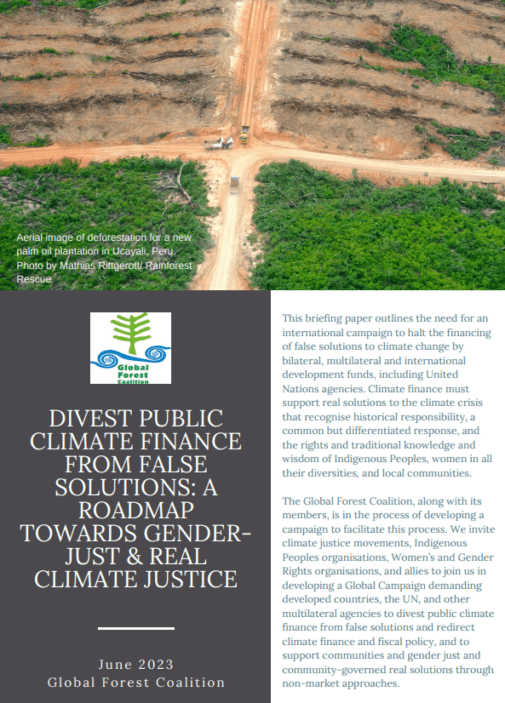Un futuro sombrío para la financiación climática durante la COP24

Por Coraina de la Plaza
La financial climática ha sido nuevamente, una de las cuestiones más complicadas dentro de las negociaciones de cambio climático este año. Desde la firma del Acuerdo de Paris y mucho antes de esto, han habido muchas palabras bien intencionadas y promesas hechas sobre la provisión de financiación requerida urgentemente para poder abordar la crisis climática, pero la mayoría de estas promesas se las ha llevado el viento.
Continuar leyendo en ingles…
The second week of the United Nations Framework Convention on Climate Change (UNFCCC) Conference of the Parties 24 (COP24) kicked off yesterday, in Katowice, Poland, but the text on finance is still too broad for the consideration of the Ministers that have arrived to take over the negotiations, and lacks clear ways of accounting for and providing the necessary information on climate finance.

Michael Eckhart, Global Head of Environmental Finance, Citi Bank, suggests that investment bankers should take the lead on climate finance.
The 3rd High Level Ministerial Dialogue on Climate Finance took place yesterday, Monday 10th, and although some (far from sufficient) pledges were made (e.g. USD 11 million from Sweden, USD 1 million from New Zealand, and USD 120 million from Switzerland), a great deal of the discourse was once again about the need to involve and leverage finance from the private sector and through public-private partnerships (PPP). Over the last few years this has become a “mantra” in climate fora.
There are many risks associated with involving the private sector and PPPs. As the Cuban Minister rightly pointed out “Private sector investments are not the appropriate way to support adaptation, as they are profit-oriented”. He spoke about adaptation, but the same principle applies for mitigation. For instance, involving the profit-oriented private sector in projects based on forests means that money has to be made out of the projects, and therefore the forests. This usually leads to initiatives that wrongly promote market mechanisms instead of community approaches to forest protection and restoration and in some cases, even to further deforestation, for example when profitable of monculture tree plantations are established.
This also raises questions about conflicts of interest, if the body tasked with delivering climate mitigation (or adaptation) is also trying to profit from it. Likewise, issues around a lack of transparency, accountability and “traceability” are often closely linked to the private sector and PPPs. Finance from the private sector usually takes the shape of loans instead of grants and, as the Philippines delegation pointed out: “Additional financial resources should not add to debt burden”. Further still, leveraging finance from the private sector should not serve as an excuse for developed countries to elude their climate finance responsibilities. Public money to address the climate crisis has been pledged, but these pledges have to actually materialise, escalate, and then be directed towards real solutions.
But how has the issue of climate finance arrived at this point? During the UNFCCC intersessional in Bonn (30th April-10th May) and the extra session that took place in Bangkok (4th-9th September), the agenda items related to finance saw very little progress. Developed countries refused to start a process that would set a new financial goal for 2025, arguing that it was too soon to have that discussion, and that the PA does not mandate a timeline to start the process anyway.
We left Bangkok with a more streamlined and shortened draft text on the methods for accounting for financial resources (Article 9.7), but still full of brackets and brackets within brackets, and open to parties adding new text during the current negotiations. The lack of progress on climate finance has continued here at COP24. And now that Ministers are to take over from the negotiating teams, there seems to be very little hope that developed countries will deliver on their moral obligation to provide the urgently-needed finance to developing countries, many of which are already suffering the deadly impacts of climate change.
To understand the current situation, it is important to look at some of the highlights of the Green Climate Fund (GCF) over the past year. GCF is envisioned as the main body that will distribute climate finance raised through the UNFCCC process. At GCF board meeting 20 (BM20), which took place last July, board members failed to reach consensus and agree on anything, including project proposals and policies that support investment criteria. This stalemate led to a crisis of confidence which permeated the climate talks in Bangkok.
Given the massive failure of BM20, things did not look good for the following board meeting, BM21, which took place in Bahrain in October. Board members were under a lot of pressure to make decisions and approve projects and, this time, they dealt with some relevant issues such as replenishing the fund and approved a total of 19 projects for a little more than USD 1 billion. However, other key items like updating the gender policy and action plan had to be postponed again for future meetings.
Some of the projects being considered were also very controversial, such as the Indonesia Geothermal Resource Risk Mitigation Project, put forward by the World Bank. For a start, GCF disclosure policy states that as a “high risk project”, documentation must be made publicly available on the GCF website 120 days in advance of the board meeting, but it was published just 30 days in advance. The project was also strongly opposed by civil society groups in Indonesia. They sent a letter to all board members voicing, among other concerns, the lack of proper consultation with the Indigenous Peoples and local communities that could be affected by the project. The approval of GCF’s Indigenous Peoples policy was a key moment for the organisation, but it is worrying to see how quickly some projects, including this one, have been approved with such obvious disregard for the policy.
Another controversial adaptation project was debated extensively under the Simplified Approval Process, which includes small-scale, low-risk proposals for less than USD 10 million. The water sector project, to take place in Bahrain, asked for USD 9.8 million in grants and partly involved using GCF funds to clean up oil sector waste, as a way of adapting to water scarcity, which is being exacerbated by climate change. In other words, the proposal was a subsidy to the oil industry. To add to the nonsense, there was no mention of the project being part of a strategy to phase out fossil fuels and, although the proposal stated that the project aimed to benefit small-scale farms owned by women, there was virtually no indication of how this might be achieved.
Civil society groups made a strong intervention against the project and, after hours of closed-doors consultations, the proposal was slashed to USD 2.1 million, focusing solely on strengthening the capacity of Bahrain’s Water Resources Council to improve demand-side management. But the most pressing question is how such a non-transformative project with such weak climate rationale could possibly pass through the Secretariat and Independent Technical Advisory Panel’s (ITAP) screening process in the first place? The ITAP did in fact raise serious concerns about the project, but it still made it onto the table for consideration.
The answer to this question may be related to a trend that has developed within the fund over the last few years, which is to consider a project proposal from the country hosting the board meeting, regardless of how suitable or in-line with GCF criteria it is. Hopefully this will not be repeated in the future, as board members should evaluate projects on their merits alone, and any potential conflicts of interest should be avoided at all costs.
As civil society groups have expressed, there are other unfortunate trends going on in the GCF, such as the increasing involvement of multilateral development banks, and international financial institutions, as opposed to national or regional-level organisations that are likely to be much more sensitive to local contexts. The involvement of larger financial intermediation programmes is also on the rise, which is quite problematic in terms of accountability and transparency. GCF projects are increasingly dependent on private-sector finance, as discussed already and, despite GCF’s promises for a 50/50 allocation of funds between adaptation and mitigation, funding for adaptation is still behind mitigation, and a growing number of cross-cutting proposals make the numbers blurrier.
BM21 also agreed to replenish the fund, where developed countries will hopefully scale-up their finance commitments and fulfill their existing obligations and promises. But this supposedly good piece of news will be negated by the inaction and backtracking of developed countries, seen here in Katowice with the push to avoid language on “new and additional” finance. And even though a number of pledges have already been made, it remains to be seen if they will ever materialise, like many of the past pledges made over the years. A new USD 200 billion pledge from the World Bank does not bode well either, as any grants will undoubtedly come with many strings attached. Or, if the finance were to come in the form of loans, then this would defeat the purpose of delivering climate finance that makes polluters pay.
COP24 is not over yet, and we will have to wait for a few days to see what the outcomes for climate finance in the Paris Rulebook are. But, until empty promises are actually turned into concrete, no-strings-attached financial action for developing countries, a gloomy future remains on the horizon.







